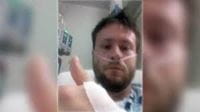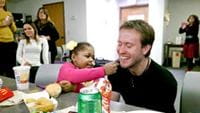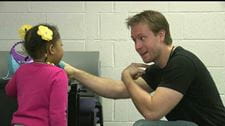After a Difficult Start, a Little Girl Finds Hope
How a living-donor liver transplant saved a child’s life
 Little Jamie Folmar has faced some significant challenges in her life. Just five years old, she has been in foster care since birth, and she was born with biliary atresia. This rare disease traps bile in the liver, leading to liver failure and, in some cases, death. Fortunately for Jamie, she has a strong support system in place.
Little Jamie Folmar has faced some significant challenges in her life. Just five years old, she has been in foster care since birth, and she was born with biliary atresia. This rare disease traps bile in the liver, leading to liver failure and, in some cases, death. Fortunately for Jamie, she has a strong support system in place.
“She is a wonderful little girl,” says Marilyn Pape, a director with the Trumbull County Children Services, near Youngstown, Ohio. “She’s so funny—she loves to sing, and she can recite so many lines from movies. She even acts them out.”
Marilyn’s fondness for Jamie is readily evident. Because Jamie came to her agency at just a few weeks old, Marilyn has watched over her almost like a devoted aunt. She has worked with Jamie’s birth family and foster family for years to ensure that the little girl and her brother, Jeremiah, have everything they need. It was only natural that Marilyn would take the lead in finding Jamie a new liver.
A rare disease with dire consequences
Biliary atresia affects only about one in every 18,000 infants, and it is more common in girls and in people of African American ethnicity. The first clue is jaundice, when the bile ducts are not working, alerting caregivers to the possibility of the condition.
In biliary atresia, the openings of the hepatic ducts do not function normally, and this impedes the flow of bile from the liver into the gallbladder and the small intestine. Without a normal flow of bile, digestion is impaired, and toxins build up in the liver. Eventually, the backed-up bile damages the liver, resulting in scarring, loss of liver tissue, and cirrhosis. Children with the disease may require a liver transplant in order to live.
When Jamie arrived at Trumbull County Children Services, she had already been diagnosed with biliary atresia. Before long, she became very ill. Bloated and jaundiced, she was in and out of the intensive care unit several times before she was referred to UPMC Children's Hospital of Pittsburgh.
“In January of 2015 we learned that Jamie was very sick; she was not going to be leaving Children’s Hospital without a new liver,” says Marilyn. Some days, Jamie was inconsolable; the hospital had become her new normal. But, on other days, Jamie’s sunny personality showed through, and she didn’t seem as sick as she was.
Finding a donor, the modern way

Liver transplants are not easy, and finding a donor is often one of the hardest parts. Deceased-donor livers are difficult to obtain. Liver tissue from a living donor is often the best choice: once a donor is identified, the surgery can occur much sooner, before the recipient becomes too ill for the surgery. Realizing that time was of the essence, Marilyn and the director of her agency got in touch with a group called Keynote Media. Keynote set up a social media awareness campaign for Jamie free of charge, and within a day, her Facebook page, “A Liver for Jamie” went live. Television and newspaper coverage were also part of the effort to find Jamie a liver donor.
The requirements for a living donor in Jamie’s case were restrictive, but the response to the media campaign was incredible. Nearly 500 people contacted UPMC’s Liver Transplant Program of the Thomas E. Starzl Transplantation Institute and offered to be tested as a potential donor. Fortunately, David Denovchek, a 32-year old veterinary technician, also became aware of Jamie’s need. David already possessed one of the most important requirements to become a liver donor: he had a caring heart. After seeing Jamie’s story on the local news, he knew he had to do whatever he could to help.

David got in touch with UPMC immediately after he learned about Jamie’s need. Testing followed soon thereafter, and his bloodwork looked promising. The experts at UPMC informed him that he would be a back-up donor, because a primary donor had been identified—but two hours later, he learned that the primary donor was no longer in the picture. He would be the one to save Jamie’s life.
“I thought I was just going in for bloodwork,” says David. “To go from that to learning that you’re going to be a donor was a bit of a shock.” But, because of his work in the medical field, he wasn’t at all nervous or frightened. His parents and brother supported his decision. “I knew it was the right thing to do,” he says.
Because he would need to take a considerable amount of time away from work, he set up a GoFundMe page to cover expenses. When he told his colleagues what he was about to do, they initially thought he was joking. “I’m a bit of a prankster,” he says. But as they learned more about his commitment to donating part of his liver to save a little girl’s life, they realized he was serious. “They were unbelievably supportive,” David says. “You need that if you’re going to do something like this.”
Successful surgeries…and a chance for a more typical childhood
In May, in simultaneous procedures that took the better part of a day, Jamie received 20 percent of David’s liver. George Mazariegos, MD, FACS, chief of Pediatric Transplantation, and Rakesh Sindhi, MD, director of Pediatric Transplant Research at Children’s, performed Jamie’s surgery, and Abhinav Humar, MD, chief of UPMC’s Division of Transplantation and Clinical Director of the Starzl Transplantation Institute, took care of David.
“When we saw the condition of Jamie’s liver, it was much worse than we had initially suspected,” says Dr. Mazariegos. “We hope that with proper care and follow-up, this gift could be a lifelong one."
 Both procedures went well. Jamie overcame a few setbacks after surgery; she was initially discharged without a feeding tube, but a subsequent infection required its re-insertion. Jamie is resilient, however. She was soon feeling better, and the time came for her to meet David. “She was wary at first,” recalls Marilyn, “but within just a few minutes she was chasing David around, giggling and feeding him French fries. It was as if they’d known each other forever.”
Both procedures went well. Jamie overcame a few setbacks after surgery; she was initially discharged without a feeding tube, but a subsequent infection required its re-insertion. Jamie is resilient, however. She was soon feeling better, and the time came for her to meet David. “She was wary at first,” recalls Marilyn, “but within just a few minutes she was chasing David around, giggling and feeding him French fries. It was as if they’d known each other forever.”
“She’s the same as I was at that age,” David says fondly. “She’s just a happy little ball of crazy. We run around and play hide-and-seek. Every time I see her, it seems like she’s grown six inches!” David sounds like a proud uncle when he talks about Jamie; the affection in his voice shines through. “She’s growing like a weed,” he says.
Today, Jamie’s liver levels are close to normal. She no longer needs a feeding tube, and she is learning how to eat again. “It’s a challenge to get her to eat her vegetables,” says Marilyn. Like so many children these days, Jamie would rather eat chicken nuggets. She went on her first outing last Halloween, trick-or-treating as Olaf from the Disney film Frozen. (Her brother was a Teenage Mutant Ninja Turtle.) Jamie is excited to start kindergarten and meet new people in the fall, and she enjoys her visits with her friend, David. Jamie and Jeremiah are still hoping for a permanent family.
“If anybody out there thinks they could become a liver donor, they should look into it,” David says. “You need to make sure you have a support system, and there’s a lot involved in the process, but if you think this is something you can do, do it.” David’s one-year check-up is approaching; he expects that everything will be perfectly normal.
 Everybody at Trumbull County Children Services is grateful for David’s help. When the Tribune Chronicle and the Trumbull 100 presented him with its 2016 Community Star Award, Jamie held David’s hand as he went up to receive the honor. The agency also awarded David its Community Partner Award at the “2016 Rising Up and Moving On” recognition luncheon, which acknowledges volunteerism, commitment, and generosity toward children. Many others in the community have also bestowed honors as a way of thanking him.
Everybody at Trumbull County Children Services is grateful for David’s help. When the Tribune Chronicle and the Trumbull 100 presented him with its 2016 Community Star Award, Jamie held David’s hand as he went up to receive the honor. The agency also awarded David its Community Partner Award at the “2016 Rising Up and Moving On” recognition luncheon, which acknowledges volunteerism, commitment, and generosity toward children. Many others in the community have also bestowed honors as a way of thanking him.
“We just can’t say enough about David and about the people at Children’s,” says Marilyn. “We were so relieved that they brought Jamie through this. She was there from January to July (of 2015) and the staff and the nurses treated her like family. We’re all just so thankful.”
View news stories of Jamie’s journey through liver transplantation:
“A Liver for Jamie”
Facebook
"Trumbull County foster child in need of new liver"
WFMJ.com (4/14/15, updated 5/9/15)
"Ohio county agency makes plea to find new liver for foster child"
WWLP.com (4/22/15)
"4-year-old foster child in desperate need of liver transplant finds donor"
WPXI.com (5/20/15)
"Meet the man who’s donating a liver to Jamie, 4"
WKBN 27 (5/21/15)
"Foster child, 4, recovering after miracle liver donation"
WTAE.com (5/29/15)
"Foster child who received liver transplant reaches new milestone, heads back to Ohio"
WPXI.com (9/22/15)
"Jamie, now 5, meets stranger who donated liver that saved her life"
WPXI.com (12/7/15)









